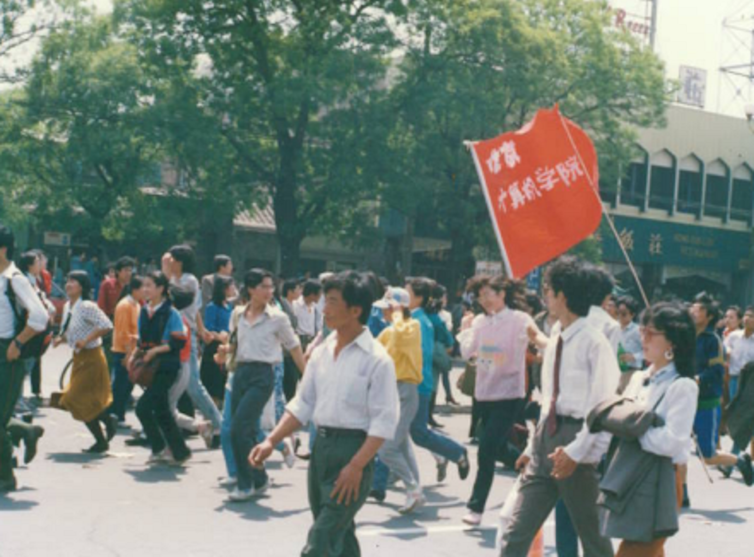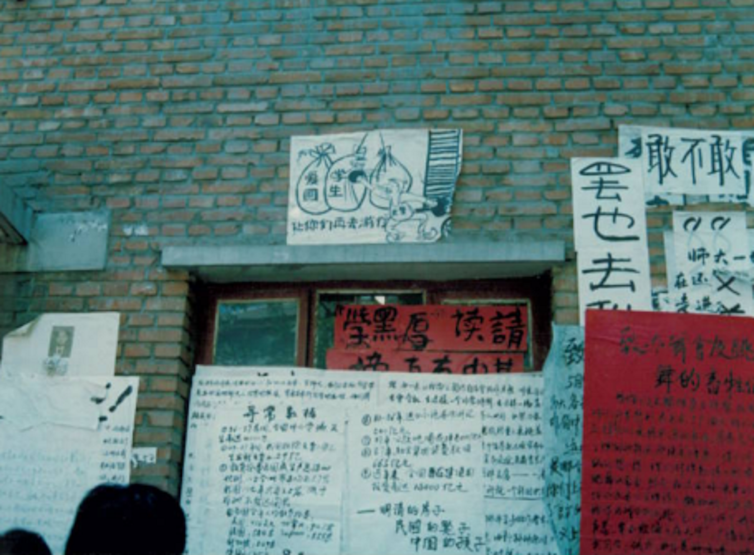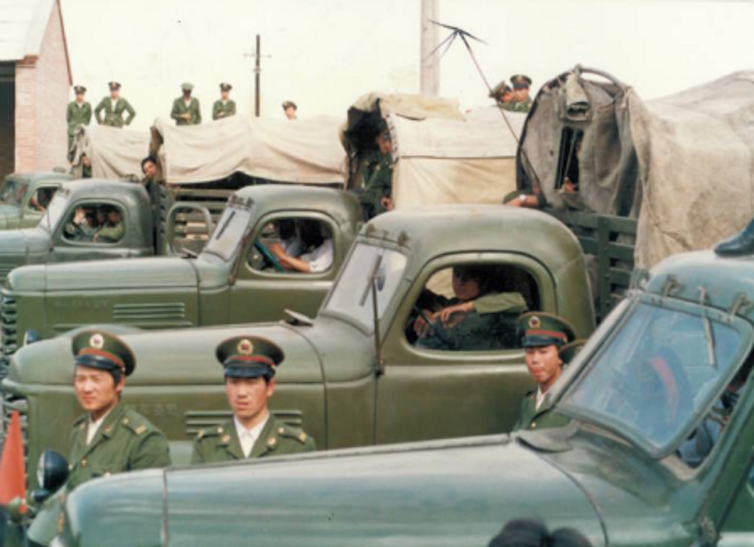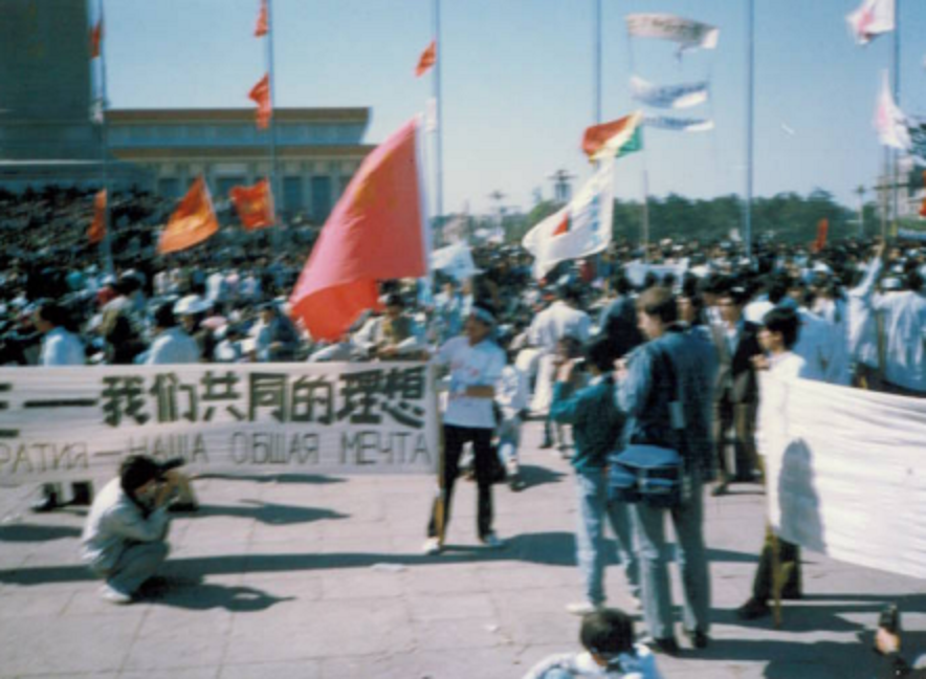In the early evening of Saturday, June 3 1989, cycling with a couple of friends along the canal to the north of the Yonghegong temple, I witnessed a remarkable display of traditional Beijing folk music. A group of old men in worn, blue-grey “Mao suits” singing along to the wistful sounds of their erhu strings and sheng pipes, created an ominous atmosphere in the humid twilight of the evening.
“What do they know that we don’t know yet?”, I jokingly asked my companions. The answer arrived within hours – also by means of music, although this time to the shrieks and crackles of the Internationale being broadcast at maximum volume around the campus of Beijing Normal University, where I was a student that year.
The hymn of the socialist international movement had become the song symbolising the student movement of 1989 and all of us immediately knew that the latter was in trouble when we were abruptly awoken from our slumber. Metallic tannoys announced that tanks had entered Tiananmen Square (天安門廣場), urging all students and lecturers to defy the soldiers. Thus ended the most recent spontaneous, non-orchestrated mass movement China’s capital had seen since May 1919.
Among the many contributions which are bound to appear on the 25th anniversary of the military intervention against these popular protests, most are likely to focus on the continuing denial by the Chinese authorities that anything ever did take place: crackdown, protests or indeed the reasons behind the latter.
Baffling as this may seem, this does bring back memories of perusing the daily press in the weeks leading up to the June 4 bloodshed, following the imposition of martial law a fortnight earlier. Echoing the new Party line, an “extremely small number” (極小數) of dangerous troublemakers had usurped the main thoroughfares of central Beijing in order to oppose the Communist authorities. The People’s Liberation Army had been called in to contain and reverse the ensuing “chaotic disorder” (暴亂), the June 4 operation constituting the crowning glory of its heroic fighters.

Equally disorienting were the simultaneous reports in the Western media which, in the pre-internet era, were only sporadically available in China. The students who had taken to the street were apparently engaged in a struggle for “freedom” and “democracy” – both symbolised by the statue so evocatively placed opposite the Mao Zedong portrait adorning the Gate of Celestial Peace, the very Tiananmen.
To the Western reporter, the obvious parallels were visible in the organised discontent which had gripped most European satellite states of the Soviet Union by then, personified by Poland’s Solidarnosc. Entire populations held hostage by Communism were looking West, and China’s youth were perceived to be doing precisely this.
Presuming the protesters had a political message, what would this have been? All started, on 15 April 1989, with the death of Hu Yaobang, the paragon Party leader admired by China’s intellectuals as a defender of their freedoms and social status. While the market reforms unleashed by Deng Xiaoping since 1980 had produced considerable wealth for farmers and salesmen, anybody tied to a state-determined salary not only fell behind in terms of relative income, but actually saw their livelihoods reverse due to the significant inflation of the late 1980s.
The head teacher responsible for us overseas students put it into simple terms: “A teacher’s salary is not enough for two packets of cigarettes. All we earn goes up in smoke!” And, as a married family man, he was lucky. His younger, unattached peers had to share dormitory accommodation, patiently queuing for simple lunches with their chopsticks and metal bowls.

In other words, the movement which erupted in support of the departed leader was one of aspirational social justice. An idealistic movement by educationalists who were left feeling marginalised in a society where material wealth mattered more and more.
Student protest becomes mass movement
The authorities, initially satisfied with the open support for the Communist Party and its leaders, became increasingly disconcerted when the demonstrations in support of the Communist ideals failed to come to an end. Again, the universities were the driving force; art classes being turned into banner painting sessions, history lessons used in order to explain the contradictions within the current political system, while our language classes became essential tools for translating the latest slogans we had seen and for deciphering the public posters which could be seen in designated spaces belonging to our vast campus.
As the weeks took their course, more and more people from other walks of life joined in; first the journalists and artists, then shop attendants and drivers and finally industrial workers who had downed their tools in order to take part in the mass demonstrations which were organising themselves, without any central planning whatsoever, in defiance of laws aimed at curtailing the public right to take to the streets.
Social justice was a call sufficiently broad for most urban workers to identify with. And suddenly there was another point being publicly made, if expressed privately long before: Communist cadres were seen as leading particularly privileged lives, profiting from the market reforms in unforeseen ways. In other words, the movement quickly became one against official corruption.
There was a final element which most of the Western media ignored and which none of the official responses dealt with. The 1989 mass movement took great delight in the frivolous freedoms which the collapse of everyday public order brought along. Spontaneous street concerts, often to the tunes of the nascent Chinese rock music scene, shops handing out small cakes and water to demonstrating bypassers, that motorbike caravan which would worm its way through the whole of central Beijing, to the delighted cheers of tens of thousands, portrait painting and art performances testing the limits of public guidelines and of social conservatism.
And those ubiquitous meat stick sellers with their little barbecue trolleys, appearing from nowhere, often directly after a scuffle with the police. Nobody enjoyed the lifting of the uniform order more than our fellow Chinese students, who would smuggle us into their dormitories, sneaking past the door guards wrapped up to our noses into big overcoats for heady discussions about the future and a degree of frankness which I had never encountered before during my time in China. In other words, the movement of the spring of 1989 was also one calling for personal, almost hedonistic freedoms. Its crushing came as a surprise to us all.
Ferocious crackdown
Soldiers had habitually returned to their base camps, having been persuaded by the students guarding the main traffic intersections that there was no revolutionary movement on the streets of the capital after all. But the latest troops recruited into Beijing were of different origin (Shenyang, we were told) and therefore more difficult to communicate with. Yet they looked placid and, certainly, the Chinese People’s own Liberation Army would hardly be shooting their own comrades. That this most unlikely scenario eventually emerged, with astonishing ferocity, took all of us by surprise.

In disbelief I turned on the TV set in order to watch the early morning news programme, but the only announcement to be broadcast was a somber sign reading “Tiananmen Square is being cleansed with blood” (血洗天安門廣場) – a final act of defiance by the TV producers who knew that any freedom to broadcast independently of the political authorities would evaporate in the wake of the crackdown. As class representative, my task was to ensure that all my fellow students were safely accounted for. But since nobody could have predicted the date nor the degree of danger they would be faced with, several students had proceeded to the Square, as on most other nights, in order to inhale the carnivalesque atmosphere.
These students I was now looking out for, locating nearly all “missing sheep” in and around the area where the military had struck. Teargas-induced irritations apart, nobody was hurt, but this could not be said for many others in the Square. Blood stained the pavements, the tarmac was ploughed up by tank chains, rows of parked bicycles had been flattened by heavy vehicles and buses – arranged into impenetrable blocks in order to deter the progress of the military – were burning, billowing out black, reeking smoke. Pedal-powered three-wheelers kept carting wounded protesters but occasionally also soldiers to Beijing’s hospitals.
Friends working in one of these hospitals disclosed news which I experienced as particularly shocking, namely that the blood of the soldiers they had treated contained high levels of amphetamines – the ultimate explanation as to why the soldiers who carried out the atrocities of June 4 were so trigger-happy. Was there a “massacre”? Beyond any doubt, regardless of whether the dead were measured by the hundreds or thousands. When I later – through the zoom lens of a press photographer’s camera positioned in a tall building near Jianguomen – watched a pile of corpses being set alight, right next to the Martyrs’ Column in the heart of the Square, I knew that the Party would want to keep the scale of what had happened in the morning of June 4 1989 a secret. The jolly pensioners whose wondrous sounds I had listened to just a few hours earlier suddenly had a prophetic air to them.

